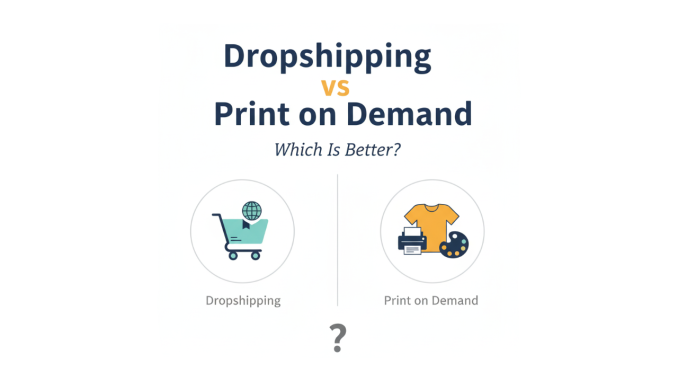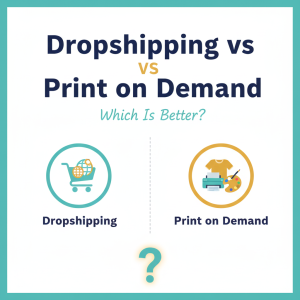
So you want to kick off an online store but don’t want to drop a fortune on a bunch of inventory that’ll just collect dust? Classic. The two main roads people go down are dropshipping and print on demand (POD). On the surface, they both look like a sweet deal—no piles of boxes, no giant upfront costs, no risking your savings on knick-knacks nobody wants. But the way they actually work? Whole different ballgame. With 2025 creeping up fast, you don’t want to sleepwalk into the wrong model.
Let’s dig in and really break down what these two are all about—the perks, the pain points, and what actually makes sense for you right now. And yeah, I’ll throw in some of my own takes because, honestly, some of this stuff just needs to be said.
What’s the Deal With Dropshipping and POD, Anyway?
Dropshipping is pretty much the ultimate “set it and forget it” for beginners. You pick out products from a supplier—could be anything, from phone cases to those weird neck pillows—and list them on your shop. When someone buys, you just pass the order along to the supplier. They deal with the whole mess—packing, shipping, the whole warehouse circus. You? You just kick back and count your cut. No inventory, no shipping station in your garage, no label printer drama.
Now, print on demand (POD) is kind of like dropshipping’s cooler, artsy sibling. Instead of selling generic stuff, you actually get to put your own spin on things. You design a graphic, slap it on a t-shirt, mug, or even a yoga mat if that’s your thing. When someone orders, the POD company prints your masterpiece, packs it up, and ships it out. Again, zero inventory headaches. It’s like being a designer without ever touching a screen printer.
Why Do People Mix These Up?
It’s not hard to see why people confuse the two. Both let you open a store with barely any cash up front. You’re not stuck with crates of unsold junk. You’re more of a marketing wizard than a factory boss. And startup costs? Way lower than opening a physical shop where your main customers are probably your mom and your nosy neighbor.
You don’t have to fuss with shipping or returns logistics—the supplier’s got it. Which is why a lot of folks just mash them together as “same thing, different name.” But trust me, the deeper you get, the more the cracks start to show.
So, Where Do Dropshipping and POD Actually Split?
Here’s where the plot thickens—these two models each have their own flavor.
-
Customization & Branding
If you’re the type who wants your store to actually stand out, POD is a total game changer. You get to make unique stuff, plaster your brand all over it, and really make your store feel like your own. Dropshipping? Eh, not so much. You’re usually pushing the same products as fifty other stores, so trying to make your brand pop can feel like yelling into the void.
But hey, in dropshipping, maybe you’re not worried about being unique. Maybe you’re just out here to sell what sells and rake in volume. That’s valid—just know it’s a crowded arena.
-
Product Selection & Shipping Speed
Now, dropshipping has the upper hand when it comes to variety. You can sell basically anything under the sun—gadgets, pet toys, kitchen gizmos—and since the stuff is already sitting in a warehouse somewhere, it usually ships pretty fast. POD? Every single item is made to order, so your customer’s gotta wait for the thing to get printed before it even ships out. Not great for the “need it now” crowd, but if people dig your designs, they’ll wait.
-
Margins & Competition
Here’s the not-so-glamorous part of dropshipping: since a bazillion other stores are selling the same thing, you’re probably going to be battling on price. Margins get razor thin real quick. You can make it work, but you’ll be hustling hard. POD, on the other hand, lets you charge more because you’re offering something nobody else has. Sure, your base costs are higher, but if your designs hit, you can get away with fatter margins.
Still, don’t fool yourself—POD isn’t some goldmine. You’ve gotta put in real creative work, or at least fork out for designers who know what’s up.
-
Risks & Operational Headaches
Both models save you from the “oh crap, I can’t sell this inventory” nightmare, but you’re not off the hook. Dropshipping brings its own headaches—suppliers can flake, shipments go missing, stuff gets backordered. And if your supplier screws up, guess who your customers blame? Yep, you. POD has its own drama: maybe your design looked amazing on your laptop but prints like a potato, or maybe your supplier’s running behind and your customers are getting antsy.
So, neither model is totally hands-off. You still have to babysit your business, just in different ways.
Which One Wins in 2025?
Honestly, there’s no “right” answer, just what fits your vibe and your skills. Here’s how I’d size it up:
Go for dropshipping if:
You want to experiment fast, try different products, and see what sticks.
You’re a marketing machine and can bring in the traffic.
You care about faster shipping and having a big, wild catalog.
You don’t mind fighting for every sale with razor-thin margins.
Lean toward POD if:
You want to actually build a brand and have full creative control.
You’re into designing, or at least can hire someone who is.
You can live with longer fulfillment times (because art takes time, right?).
You’d rather have a tight collection of unique stuff than a Walmart-sized catalog.
What’s Trending for 2025?
Personalized stuff is blowing up. POD is growing like crazy—people want stuff that feels custom, not cookie-cutter. Plus, sustainability is in, and made-to-order is less wasteful than mass production.
Dropshipping is still alive and kicking, but the competition is getting gnarlier. Everyone and their cousin is opening a dropship store, so if you wanna stand out, you’ve gotta be sharp—find a niche, build a brand, and get creative with your marketing.
Pro tip? Don’t be afraid to mix it up. Some of the savviest store owners are blending POD, dropshipping, and even digital products to keep things fresh and diversified. That way, if one stream dries up, you’re not out of luck.
Final Thoughts
Here’s the real talk: don’t pick a model just because some YouTube guru told you it’s “passive income.” Both dropshipping and print on demand take hustle—just in different ways. If you’re the creative type and want to build something that’s all yours, POD is probably your best bet. If you’re more into testing products and scaling up fast, dropshipping could be your playground.
But whatever you do, don’t just race to the bottom on price. Focus on making your store legit—think quality, branding, and customer experience. In 2025, with a million stores out there, the ones that actually stand out and make people feel something are the ones that’ll stick around.
So yeah, pick your path, put your stamp on it, and don’t forget to actually care about your customers. That’s how you win, no matter what year it is.



Leave a Reply